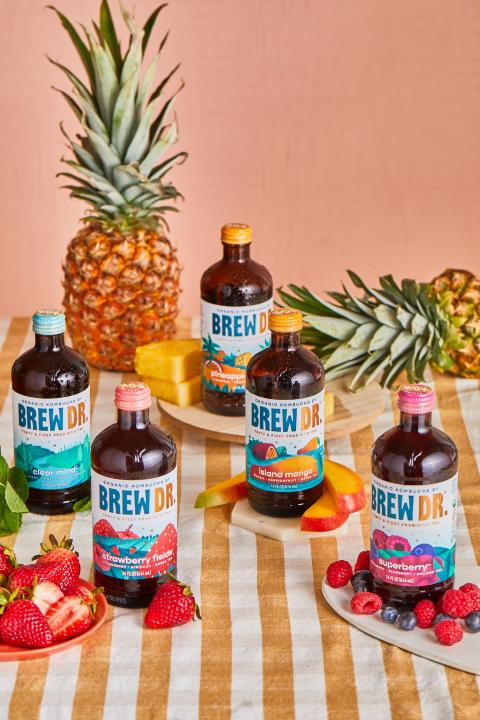What Draws Today's Consumers to Functional Beverages?

Functional beverages have been on the market for years, but it’s clear the pandemic helped hammer home a greater consumer interest in health-focused, immunity-boosting food and drink. New flavor options and innovative ingredients are proliferating within the market, lending to a renewed interest in everything from probiotic-packed kombucha and protein shakes to standard juices with extra vitamins and minerals.
According to Grand View Research, the global functional beverage market was worth $204.8 billion in 2022 and is expected to grow at a compound annual growth rate of 7.1% from 2023 to 2030. The market research and consulting company asserts that increasing awareness regarding the health benefits of consuming functional drinks as well as growing marketing efforts and innovative product launches will both fuel that market growth.
[Read more: "Stress, Inflation Impacting Healthy Food Choices: IFIC"]
Flavor and Health Imperatives
While health benefits are obviously an important part of the appeal of functional beverages, Mintel recently found that 43% of consumers are more likely to try a new drink based on appealing flavor over its functional benefits. Mintel’s report stresses that flavor innovation can interest fresh audiences and also reinvigorate curiosity in consumers already familiar with a line.
“Consumers across the health spectrum are attracted to flavor,” the report further stated. “Wellness inclinations can be measured through label reading behaviors, seen through consumers’ preference for long-term versus short-term benefits, and flavor’s appeal is universal across these behaviors. Flavor serves as the initial window of introduction to communicate function and benefits of consistency.”
Dan Stangler, CEO of kombucha company Brew Dr., understands the importance of offering flavor-forward beverages, and says the company’s flavor innovation comes directly from consumers via both qualitative and quantitative research.
“We’re a leader in the more herbal and botanical flavors, like our Clear Mind and Love,” Stangler explained. “But we know from consumers that they’re interested in more fruit-forward flavors, so this year we launched Strawberry Fields and Pineapple Paradise, which have been very well received. We continue to listen to consumers and we try things out with our seasonal line.”
Beyond flavor, and looking at the broader functional beverage space, Stangler believes there are five main attributes where companies are innovating and consumers are paying the most attention, including taste, health, convenience, value and values. As such, Stangler points to shoppers seeking out beverages with less sugar and artificial sweeteners, as well as gut health ingredients like prebiotics and probiotics, and performance additives around both energy and mental acuity.
Indeed, Mintel found that communicating both value and company values is an imperative piece of the puzzle, but grabbing customers’ attention first is of the utmost importance.
“Appealing to basic daily nutrition needs through functional claims and ingredients will stay evergreen as the functional space continues to evolve,” explained Adriana Chychula, Mintel’s food, drink and nutrition analyst. “Niche claims and ingredients can generate excitement, but novelty factors and whim purchase tendencies may require communications based on consistency to sustain this engagement.”
Continued Chychula: “The importance of the basics is seen through consumers' current habits – they report high engagement with hydration claims and drinks with added vitamins and electrolytes over more niche functions and ingredients. These are human needs that need to be met regularly, so they have a lower barrier to consistent engagement.”
How to Gain Market Share
“Functional drinks are a rapidly evolving space, challenging brands to keep pace with emerging trends without losing sight of the basics,” said Chychula. “In any case, flavor serves as an introduction; working backwards to connect related ingredients to micronutrients and their broader functions can satisfy thirst, with science-backed wellness to justify whim purchase.”
Mintel reports that doubling down on reinforcing the benefits of consistently consuming functional beverages will support deeper engagement among current users. Millennials are currently the most frequent users, but other groups including Gen Z and Gen X, have demonstrated strong interest and current use.
As for increasing shopper interest in these types of drinks at retail, Molly Hembree, a registered dietitian coordinator for The Little Clinic and Kroger, recommends trying to offer many popular functional beverages in both single-serve and jug-size options so customers can try them first and then commit to a bigger size on the next shopping trip.
Grocers can also offer discounts on stacking different products: A medley of various functional beverages can come with a better price tag than one purchased separately. An additional refrigerated beverage case near fresh ready-to-eat meals can also make it a no-brainer for on-the-go shoppers to grab a healthy drink.

.jpeg?itok=PPwvSWS4)





